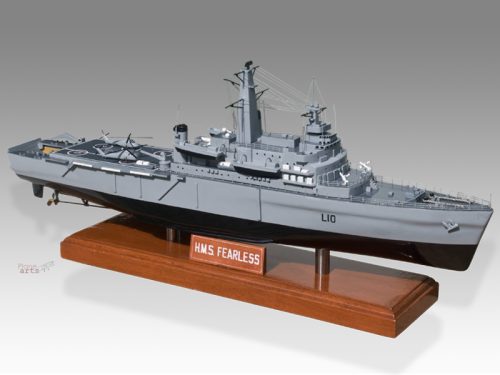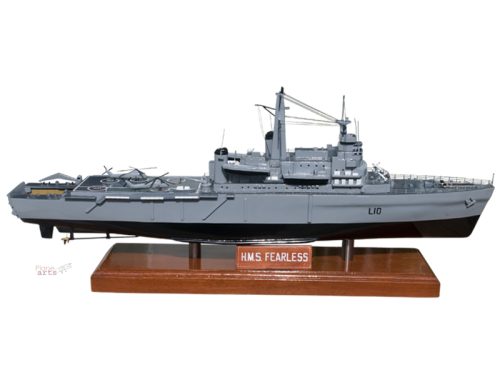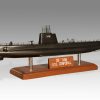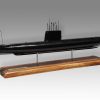HMS Fearless
Production Time 9 to 10 weeks
Shipment is by FedEx, UPS or DHL International Express Courier with a normal door-to-door delivery time worldwide of within 2-3 business days after dispatch. Due to the current volatility of world fuel prices, the amount mentioned here is our best estimate for DHL and UPS and may be subject to change at the time of shipping.

Model Description: HMS Fearless Wood Replica Scale Custom Model
Manufacturer: Harland and Wolff
$1,150.00
Production Time 9 to 10 weeks
-
United States dollar ($)
-
Pound sterling (£)
-
Euro (€)
-
Australian dollar ($)
-
Canadian dollar ($)
-
Singapore dollar ($)
-
Swiss franc (CHF)
-
Japanese yen (¥)
-
Danish krone (kr.)
-
Hong Kong dollar ($)
-
Norwegian krone (kr)
-
Swedish krona (kr)
-
United Arab Emirates dirham (د.إ)
General Product Description
Our PlaneArts HMS Fearless replica exhibits unique, unrivaled quality and detailed design to come as close as possible to the accuracy of the actual craft. It comes as standard with a robust, durable base or stand which is available in a variety of different finishes designed to match your own personal requirements including solid wood, wood with polished metal supports or adjustable wood wall mount and will be ready within about 8-10 weeks from placement of order.
The HMS Fearless model is made of the finest kiln dried renewable mahogany wood (commonly known as Lauan or Meranti) which has undergone many stages of carving and meticulous and careful sanding giving the beautiful, finished museum quality masterpiece. Many collectors and model connoisseurs demonstrate their preference for genuine handmade and hand painted mahogany wood models rather than plastic or die cast (diecast) alternatives due to the overall look and totally different feel of the item - we trust you will find the same. We can however, if required produce the same model in Solid Cast Resin so just click and contact us for further information. Our craftsmen and gifted artisans ensure that our finely handcrafted model watercraft match the precise blueprint details of the original version. The paint scheme, markings and parts are closely matched, reflecting the original. This stylish top-quality desktop replica model will surely enthrall anyone who receives this as a gift and for sure one of the most appropriate and desirably collectable gifts for any boat, ship or similar enthusiast and avid collector whilst also displaying a perfect resemblance to the actual craft itself.
If you require, we can also make this model in any other private livery, markings or colour scheme you require and if necessary, in a different size or scale. Just click here to contact us with a description or photographs of what you require and we will let you have a quotation for the necessary customization by return email. We can also make bespoke scale replicas of any other private / civil commercial airliner or airliners, helicopter, glider, gliders with engines, military jet, warplane jets, propeller warplanes, biplane, triplane, tail fin, spacecraft, rocket or NASA model you require in any airline, military or civilian livery or colors. We also produce boat and ship collectibles. Wall plaque or seal for military, government or private customers. Again, by clicking here to contact us just let us know exactly what you need.
HMS Fearless: A Retrospective on Britain’s Amphibious Assault Pioneer
The HMS Fearless (L10) was a formidable asset to the Royal Navy, serving primarily as an amphibious assault ship from its commissioning in 1965 until its decommissioning in 2002. As one of the first purpose-built amphibious warfare vessels in the Royal Navy, alongside its sister ship HMS Intrepid, Fearless played a pivotal role in reshaping naval strategies and operations concerning marine landings and troop deployments. This article delves into the key technical specifications and features that made HMS Fearless a notable figure in naval history.
Design and Construction:
HMS Fearless was built by Harland and Wolff in Belfast, Northern Ireland. The ship was laid down in 1962, launched in 1963, and formally commissioned on November 25, 1965. Designed during the Cold War, its architecture was geared towards maximizing efficiency in troop and equipment deployment during amphibious operations.
Dimensions and Displacement:
- Length: Fearless measured 520 feet (158 meters) in length overall.
- Beam: The beam was 80 feet (24 meters).
- Draught: The ship had a draught of 21 feet (6.4 meters).
- Displacement: At full load, it displaced approximately 12,120 tons.
Propulsion and Performance:
- Propulsion: The vessel was powered by two English Electric steam turbines, each driving a single shaft. This arrangement provided a total power output of 22,000 shaft horsepower (16,400 kW).
- Speed: HMS Fearless could reach a top speed of 21 knots (39 km/h; 24 mph).
- Range: With a fuel capacity that allowed it to store up to 540 tons of fuel oil, it had an operational range of 5,000 nautical miles (9,260 km) at 18 knots.
Capacity and Capabilities:
- Troop Capacity: HMS Fearless could accommodate up to 700 troops, a significant capacity that allowed for the rapid deployment of marine and army personnel during operations.
- Vehicle Storage: The ship featured a well deck that could house up to 15 tanks or more than 27 smaller vehicles.
- Landing Craft: It was equipped with four Landing Craft Vehicle and Personnel (LCVP) units and two Landing Craft Utility (LCU), enhancing its ability to deploy troops and equipment directly onto shores.
- Helicopter Facilities: The flight deck could support operations of up to five helicopters simultaneously, with hangar space for two Sea King helicopters.
Armament and Electronics:
- Armament: For self-defense, Fearless was equipped with two quadruple Seacat missile launchers and two 40mm Bofors AA guns.
- Electronics: It featured advanced navigation and communication systems for its time, including several types of radar and sonar installations essential for operational coordination during amphibious assaults.
Operational History:
Throughout its service life, HMS Fearless saw extensive action. Its most notable deployment was during the Falklands War in 1982, where it played a crucial role in the landings at San Carlos Water, providing direct support and command facilities for British forces. Beyond combat operations, Fearless was involved in numerous multinational exercises and peacekeeping missions, demonstrating the versatility and durability of its design.
Legacy and Decommissioning:
HMS Fearless was decommissioned from active service in March 2002. Its legacy, however, lives on in the lessons learned and the advancements in amphibious ship design it inspired. As one of the vessels that helped to define modern amphibious warfare tactics, the technical specifications of HMS Fearless highlight the engineering expertise and strategic foresight of its era. Today, its role and functionalities continue to influence the design and operation of contemporary amphibious assault ships around the world.
| Weight | 6 kg |
|---|---|
| Dimensions | 28 in |











Reviews
There are no reviews yet.